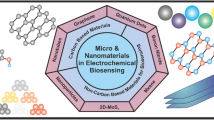Abstract
Quantitation without relying on the calibration curve has long been an issue of overcoming analytical problems accompanied with the inherent limitations of the calibration curve fitting errors. Here, we report on a calibration curve-free method for electrochemical quantitation based on a multi-scale gap device (MGD). The MGD is an integrated device having a series of interdigitated electrodes (IDE) with micro-to-nano gap distances. The device shows a gap-dependent redox current of the analyte when subjected to the electrochemical cycling between the two facing electrodes of its componential IDEs. Based on the fact that the current increases as the gap distance decreases, the analyte concentration could be directly estimated: the rate of increase in the current was directly proportional to the analyte concentration. The calibration curve was not necessary for the quantitation. The accuracy of this MGD approach was better than that of an IDE collection of the same gap distance, which was deteriorated at the larger gap distances particularly. The MGD-based quantitation of dopamine, potassium ferricyanide, and aminophenol was demonstrated in a relatively broad range of concentrations (100 nM–5 mM).
Graphical abstract







Similar content being viewed by others
References
Skuratovsky A, Soto RJ, Porter MD (2018) Adaptable detection strategies in membrane-based immunoassays: calibration-free quantitation with surface-enhanced Raman scattering readout. Anal Chem 90:7769–7776
Wo X, Li Z, Jiang Y, Li M, Su Y, Wang W, Tao N (2016) Determining the absolute concentration of nanoparticles without calibration factor by visualizing the dynamic processes of interfacial adsorption. Anal Chem 88:2380–2385
Debnath M, Farace JM, Johnson KD, Nesterova IV (2018) Quantitation without calibration: response profile as an Indicator of target amount. Anal Chem 90:7800–7803
Sheng N, Zou B, Tong H, Lu Y, Xing S, Song Q, Zhou G (2019) Sequence-encoded quantitative invader assay enables highly sensitive hepatitis B virus DNA quantification in a single tube without the use of a calibration curve. Analyst 144:5775–5784
Takahashi T, Thornton B, Ohki K, Sakka T (2015) Calibration-free analysis of immersed brass alloys using long-ns-duration pulse laser-induced breakdown spectroscopy with and without correction for nonstoichiometric ablation. Spectrochim Acta B 111:8–14
Zhao P, Wang Q, Kaur M, Kim Y-I, Dewald HD, Mozziconacci O, Liu Y, Chen H (2020) Absolute quantitation of proteins by coulometric mass spectrometry. Anal Chem 92:7877–7883
Xu C, Zheng Q, Zhao P, Paterson J, Chen H (2019) A new quantification method using electrochemical mass spectrometry. J Am Mass Spectrom 30:685–693
Tumanov S, Zubenko Y, Obolonkin V, Greenwood DR, Shmanai V, Villas-Bôas SG (2016) Calibration curve-free GC–MS method for quantitation of amino and non-amino organic acids in biological samples. Metabolomics 12:64
Nouri R, Tang Z, Guan W (2019) Calibration-free nanopore digital counting of single molecules. Anal Chem 91:11178–11184
Bai L, Carlton DD Jr, Schug KA, Kevin AS (2018) Complex mixture quantification without calibration using gas chromatography and a comprehensive carbon reactor in conjunction with flame ionization detection. J Sep Sci 41:4031–4037
Idili A, Parolo C, Ortega G, Plaxco KW (2019) Calibration-free measurement of phenylalanine levels in the blood using an electrochemical aptamer-based sensor suitable for point of-care applications. ACS Sens 4:3227–3233
Li H, Dauphin-Ducharme P, Ortega G, Plaxco KW (2017) Calibration-free electrochemical biosensors supporting accurate molecular measurements directly in undiluted whole blood. J Am Chem Soc 139:11207–11213
Zhu M, Li S, Li H, Li H, Xia F (2020) Employing an intercalated redox reporter in electrochemical aptamer-based biosensors to enable calibration-free molecular measurements in undiluted serum. Anal Chem 92:12437–12441
Marei MM, Roussel TJ, Keynton RS, Baldwin RP (2013) Electrochemical and microfabrication strategies for remotely operated smart chemical sensors: application of anodic stripping coulometry to calibration-free measurements of copper and mercury. Anal Chim Acta 803:47–55
Beck JG, Skuratovsky A, Granger MC, Porter MD (2017) Calibrant-free analyte quantitation via a variable velocity flow cell. Anal Chem 89:1147–1154
Matylitskaya V, Kasemann S, Urban G, Dincer C, Partel S (2018) Electrochemical characterization of nanogap interdigitated electrode arrays for lab-on-a-chip applications. J Electrochem Soc 165(3):B127–B134
Seddon BJ, Girault HH, Eddowes MJ (1990) Further comments on interdigitated microband electrodes: chronoamperometry and steady state currents. J Electroanal Chem 293:269–271
Aoki K, Morita M, Niwa O, Tabei H (1988) Quantitative analysis of reversible diffusion-controlled currents of redox soluble species at interdigitated array electrodes under steady-state conditions. J Electroanal Chem 256:269–282
Ferrari AG-M, Foster CW, Kelly PJ, Brownson DAC, Banks CE (2018) Determination of the electrochemical area of screen-printed electrochemical sensing platforms. Biosensors 8:53
Konopka SJ, McDuffie B (1970) Diffusion coefficients of ferri- and ferrocyanide ions in aqueous media, using twin-electrode thin-layer electrochemistry. Anal Chem 42(14):1741–1746
Robinson D, Anderson JE, Lin J (1990) Measurement of diffusion coefficients of some indoles and ascorbic acid by flow injection analysis. J Phys Chem 94(2):1003–1005
Funding
This work is supported by the National Research Foundation of Korea (NRF-2013M3A6B2078961, NRF-2016M3A7B4910538, and NRF-2017M3A7B4041973) and the Technology Innovation Program (20004103) funded by the Ministry of Trade, Industry & Energy (MOTIE, Korea).
Author information
Authors and Affiliations
Corresponding author
Ethics declarations
Conflict of interest
The authors declare no competing interests.
Additional information
Publisher’s note
Springer Nature remains neutral with regard to jurisdictional claims in published maps and institutional affiliations.
Supplementary information
ESM 1
(DOCX 2627 kb)
Rights and permissions
About this article
Cite this article
Kang, A., Ryu, J., Lee, J. et al. Calibration curve-free electrochemical quantitation by micro-nano multi-scale gap devices. Microchim Acta 188, 200 (2021). https://doi.org/10.1007/s00604-021-04861-7
Received:
Accepted:
Published:
DOI: https://doi.org/10.1007/s00604-021-04861-7




